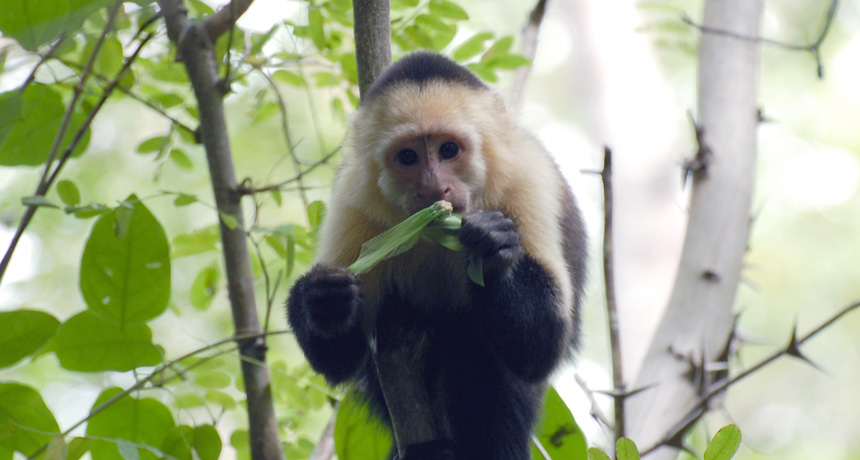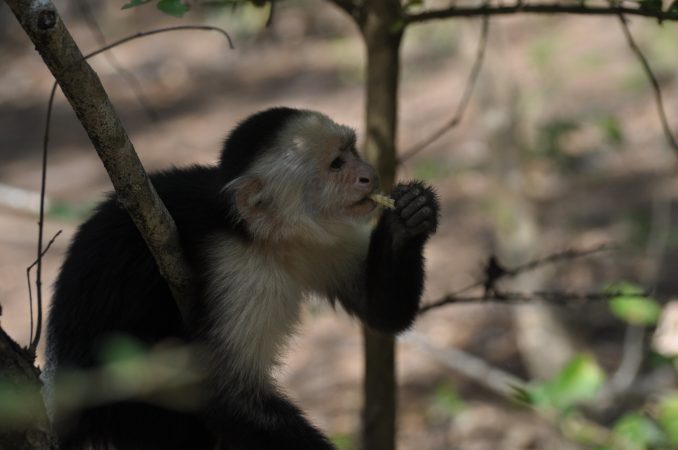Bugs may have made us brainy
New research backs a theory that insect meals helped primates — including humans — evolve better brains

A Cebus capucinus monkey in Costa Rica. It is seen here dining on a bright green katydid, an insect related to grasshoppers.
Amanda Melin
You may have small bugs to thank for your big brain and its ability to creatively solve problems, say researchers working in Costa Rica.
Primates are mammals such as monkeys, apes and hominids (a group that includes modern humans). Scientists had long suspected that finding and eating bugs when other food is scarce helped primates evolve bigger brains.
According to this theory, primate brains didn’t just get bigger, though. They also got better at handling complex tasks. Such tasks might include searching for yummy bugs hiding under tree bark and in rock crevices. Eating bugs probably also gave early primates a brain boost. Bugs are chock-full of essential fats and nutrients that help keep brains functioning properly.
It’s a good theory, says Amanda Melin. An anthropologist, she works at Washington University in St. Louis, Mo. But there also was a problem with this theory: No one had ever shown that primates actually forage for bugs when there is nothing else to eat.
So she and her fellow researchers went looking for proof.
Their five-year study of monkeys in Costa Rica now shows this is exactly what happens.

The researchers chose to follow a type of capuchin monkey known as Cebus capucinus. The reason: They already knew these monkeys were adept at finding bugs.
Monkeys in the Cebus genus prefer to eat fruit. But as the fruit season ended, the monkeys in this study went looking for bugs, the researchers found.
“They knew just which branch to rip open,” says Melin. “They’d tap branches. And at some unknown cue, they would open it up and ants would come pouring out. They’d eat them like corn on a cob.”
The monkeys also hunted katydids, which are related to grasshoppers. Huge cockroaches proved a lunch favorite, as were a type of caterpillar with a sharp spiny back. The monkeys scrubbed the caterpillars along branches to get rid of their spines before eating them. Some of the monkeys even munched on scorpions. (These are not insects but arachnids, which belong to the same class of animals as spiders and mites.) Don’t worry. The monkeys tore off the stingers before gobbling the scorpions whole.
Melin’s team published its findings in the June Journal of Human Evolution.
The researchers studied only the Cebus capucinus type of capuchins. But capuchins in another genus — Sapajus — are even better bug foragers. It doesn’t hurt that these monkeys use tools. They collect and carry sticks to poke into trees and rocks in their search for bugs.
|
A young male capuchin monkey in Costa Rica eats a katydid, a nocturnal insect related to grasshoppers. Amanda Melin |
Melin and her team have their own theory about why Sapajus capuchins have become such accomplished bug hunters. These capuchins used to live in rainforests along the Atlantic Ocean. Long ago, they moved into areas with greater changes in seasons. That would have left long stretches of time when fruit wasn’t available. The Sapajus may have adapted by hunting bugs in the off-season, the researchers suspect.
The new study seems to back the theory that foraging for bugs when food was scarce probably helped humans evolve bigger brains, says Lucinda Backwell. She’s an expert in the behavior and thinking of early hominids — a type of primate that includes humans. She works at the University of the Witwatersrand in Johannesburg, South Africa.
“More food requires more effort and greater risk,” she says. And that, she argues, “drives a need for resourcefulness and innovation,” which could have led to larger brains.
Power Words
anthropology The study of humankind. A social scientist who studies different societies and cultures is called an anthropologist.
arachnid A group of invertebrate animals that includes spiders, scorpions, mites and ticks. Many have silk or poison glands.
bug The slang term for an insect.
capuchin A forest-dwelling New World monkey that eats fruit, insects, leaves and sometimes small birds. Most have a coat of dark fur, except around the face, where it can be creamy or white. The almost hairless face is pink to gray in color. These monkeys used to be classified as belonging to a single genus: Cebus. In 2012, scientists broke off a group of robust capuchins and gave them a new genus name: Sapajus.
caterpillar The larval stage of moths and butterflies. Somewhat wormy-shaped crawlers, caterpillars tend to eat leaves and other plant bits. Some will, however, dine on other insects.
evolution A process by which species undergo changes over time, usually through genetic variation and natural selection. These changes usually result in a new type of organism better suited for its environment than the earlier type. The newer type is not necessarily more “advanced,” just better adapted to the conditions in which it developed.
fat A natural oily or greasy substance occurring in animal bodies, especially when deposited as a layer under the skin or around certain organs. Fat’s primary role is as an energy reserve. Fat is also a vital nutrient, though it can be harmful to one’s health if over consumed in excess amounts.
forage To search for something, especially food.
genus A group of closely related species. For example, the genus Canis — which is Latin for “dog” — includes all domestic breeds of dog and their closest wild relatives, including wolves, coyotes, jackals and dingoes.
hominid A primate of an animal family that includes humans and their fossil ancestors.
insect A type of arthropod that as an adult will have six segmented legs and three body parts: a head, thorax and abdomen. There are hundreds of thousands of insects, which include bees, beetles, flies and moths.
mammal A warm-blooded animal distinguished by the possession of hair or fur, the secretion of milk by females for feeding the young, and (typically) the bearing of live young.
natural selection This is guiding concept underlying evolution, or natural adaptation. It holds that natural mutations within a population of organisms will create some new forms that are better adapted to their environment. That adaptation makes them more likely to survive and reproduce. Over time, these survivors may come to dominate the original population. If their adaptive changes are significant enough, those survivors may also constitute a new species.
nutrients Vitamins, minerals, fats, carbohydrates and proteins needed by organisms to live, and which are extracted through the diet.
primate The order of mammals that includes humans, apes, monkeys and related animals (such as tarsiers, the Daubentonia and other lemurs).







